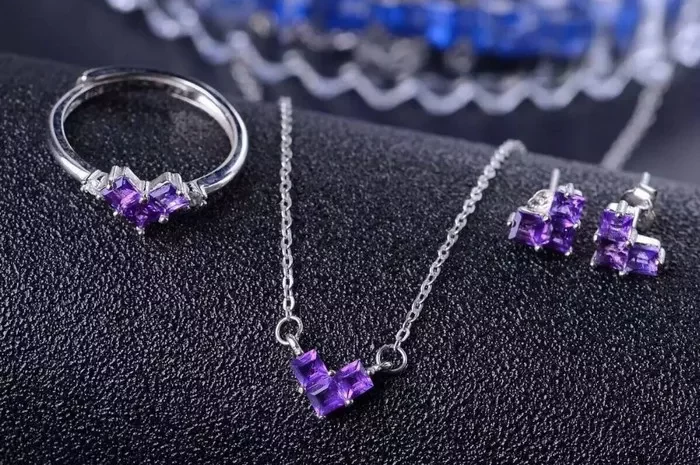Quartz, a common mineral found in the Earth’s crust, belongs to the silicate mineral family. It is characterized by its hardness, clarity, and the ability to form crystals of various shapes and sizes. Among the myriad varieties of quartz, amethyst stands out due to its unique purple hue, which has captivated humans for thousands of years. This article aims to provide a detailed introduction to amethyst, explaining its relationship with quartz, its geological formation, properties, and its significance in jewelry and culture.
Quartz: The Foundation of Amethyst
Quartz is a silicon dioxide mineral with a chemical formula of SiO₂. It is one of the most abundant minerals on Earth, found in various rock types, including igneous, metamorphic, and sedimentary rocks. Quartz crystals often form in hexagonal prisms, exhibiting a wide range of colors, from transparent to various shades of brown, yellow, pink, purple, and even black due to impurities or structural variations.
Quartz’s hardness, typically ranging from 6.5 to 7 on the Mohs scale, makes it a durable mineral suitable for various applications, including jewelry, cutting tools, and optical components. Its piezoelectric and pyroelectric properties also make it useful in electronics and technology.
The Genesis of Amethyst
Amethyst is a variety of quartz that exhibits a purple or violet coloration. This coloration is due to the presence of trace amounts of iron and other impurities within the quartz crystal structure. Specifically, the color arises from natural radiation or heat treating the quartz, causing the iron impurities to undergo a valence change, resulting in the absorption of red light and the reflection of blue and violet light.
Geologically, amethyst forms under specific conditions. It often occurs in volcanic rocks, metamorphic rocks, and some sedimentary rocks. The formation of amethyst typically involves the cooling and crystallization of magma or lava, or the metamorphosis of existing rocks due to high temperatures and pressures. In some cases, amethyst can also form through the weathering and alteration of other minerals.
One notable deposit of amethyst is found in the SiO2-rich rocks of the Urals in Russia. Here, the amethyst crystals often form in cavities within rhyolitic lavas and volcanic tuffs. These crystals can grow to impressive sizes, sometimes exceeding one meter in length.
Properties of Amethyst
Physical Properties:
Color: Amethyst’s most striking feature is its purple or violet coloration, which can range from a light lavender to a deep, almost blackish purple.
Clarity: Amethyst can be transparent, translucent, or opaque, depending on its formation conditions and impurities.
Hardness: With a hardness of 7 on the Mohs scale, amethyst is relatively durable and scratch-resistant.
Luster: Amethyst exhibits a vitreous or glassy luster, adding to its appeal in jewelry.
Optical Properties:
Refraction: Amethyst has a refractive index of approximately 1.54 to 1.55, which gives it a distinctive sparkle when cut and polished.
Pleochroism: Some amethyst crystals display pleochroism, meaning they appear to change color slightly when viewed from different angles.
Jewelry and Applications
Due to its beautiful color and durability, amethyst has been a favored gemstone for jewelry making for centuries. It is often cut into cabochons, beads, or faceted gems for rings, pendants, earrings, and bracelets. The deep purple color of amethyst is associated with royalty, luxury, and spirituality, making it a popular choice for high-end jewelry.
In addition to jewelry, amethyst has various other applications. It is sometimes used in carvings and sculptures due to its hardness and beautiful color. Its piezoelectric properties make it useful in some electronic devices. Amethyst is also believed to have healing properties in some cultures and is used in alternative medicine and spiritual practices.
Care and Maintenance of Amethyst Jewelry
To keep amethyst jewelry in optimal condition, it is important to follow proper care and maintenance practices. Amethyst is relatively durable but can still be scratched or damaged if not handled carefully. Here are some tips for caring for amethyst jewelry:
Store Separately: Keep amethyst jewelry in a separate compartment from other jewelry to avoid scratching.
Avoid Chemicals: Avoid exposing amethyst to harsh chemicals, such as cleaning agents or perfumes, which could damage the gemstone.
Gentle Cleaning: Clean amethyst jewelry with a soft cloth and warm water. Avoid using abrasive cleaners or scrubbing too hard, which could scratch the surface.
Protect from Heat: Avoid exposing amethyst to high temperatures, as this could cause the gemstone to crack or change color.
Conclusion
In conclusion, amethyst is a beautiful and unique variety of quartz that has captivated humans for thousands of years. Its purple or violet coloration, durability, and cultural significance make it a popular choice for jewelry and personal adornment. By understanding the geological formation, properties, and care of amethyst, one can appreciate this gemstone even more and ensure that it remains in optimal condition for generations to come.
Related topic:
- Pink Amethyst: A Birthstone with Charm
- Pink Heart Healing Amethyst: A Comprehensive Guide
- Is Pink Amethyst the Same as Rose Quartz?


